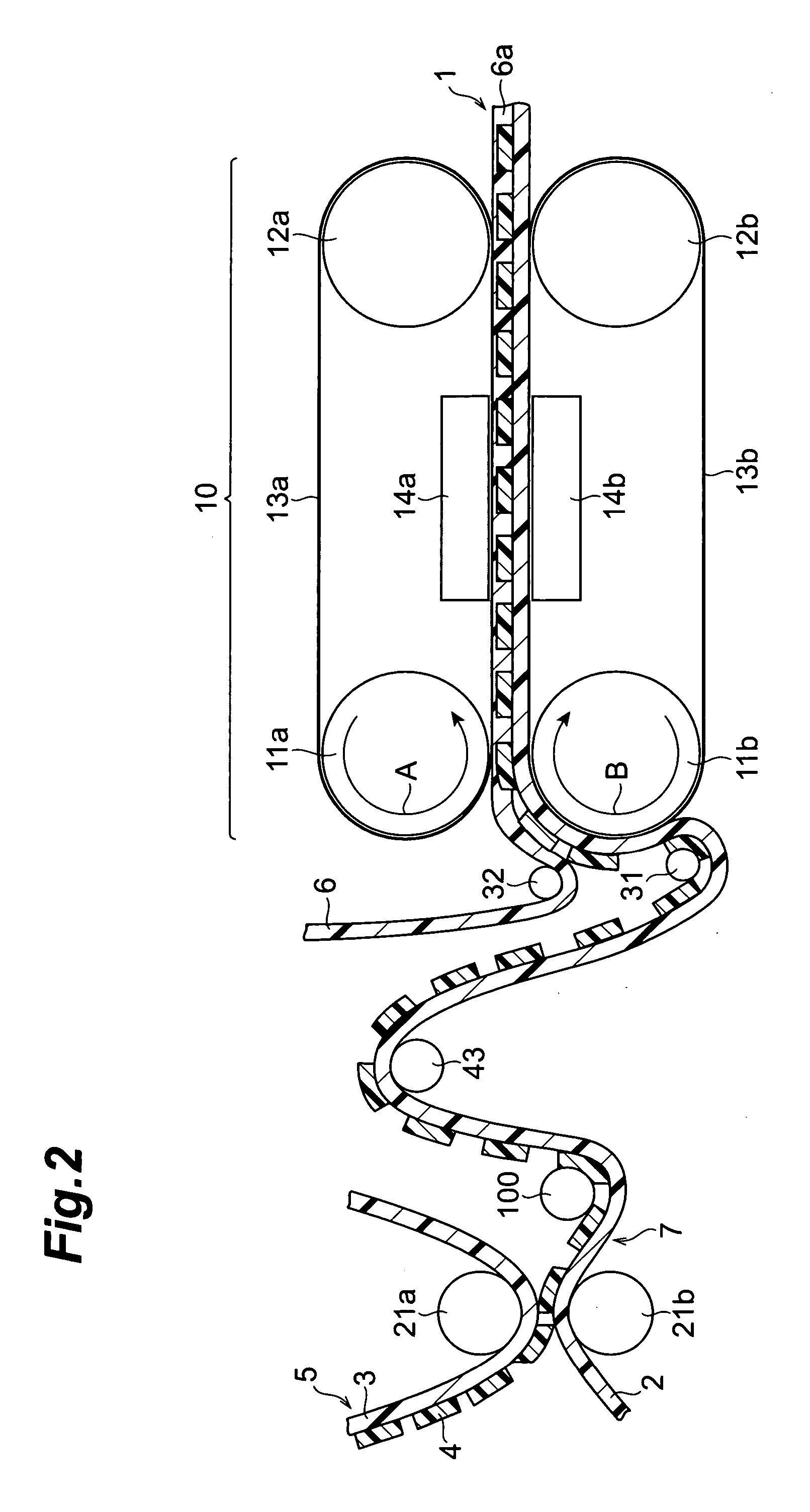Production method of decorative film
a production method and film technology, applied in the direction of synthetic resin layered products, printing, textiles and paper, etc., can solve the problems of acrylic resin, easy to print defects, and difficult printing on transparent resin layers, etc., to achieve efficient application, suppress surface defects, and improve transparency
- Summary
- Abstract
- Description
- Claims
- Application Information
AI Technical Summary
Benefits of technology
Problems solved by technology
Method used
Image
Examples
example 1
[0075]A transfer sheet with a pattern layer on one surface of a biaxially oriented polyethylene terephthalate film as a carrier film (available from Toppan Printing Co., Ltd.) and an ABS resin film as a base film (available from Shin-Etsu Polymer Co., Ltd., having the longitudinal elongation of 228%, the longitudinal tensile strength of 0.19 N / mm2, the transverse elongation of 294%, the transverse tensile strength of 0.15 N / mm2, and the thickness of 100 μm) were put between a pair of heating rolls one of which was a metal roll (at the surface temperature of 160° C.) to be stuck to each other under heat. The biaxially oriented polyethylene terephthalate film was stripped off immediately after stuck, thereby to obtain a laminate sheet with the pattern layer on one surface of the ABS resin film. This laminate sheet was rolled up.
[0076]Then, using a continuous pressing machine “LCS-D” having much the same configuration as the double belt press 10 shown in FIG. 1 and others, a transparen...
example 2
[0079]A decorative film was prepared in the same manner as in Example 1, except that an ABS resin film (available from Shin-Etsu Polymer Co., Ltd., having the longitudinal elongation of 219%, the longitudinal tensile strength of 0.12 N / mm2, the transverse elongation of 314%, the transverse tensile strength of 0.09 N / mm2, and the thickness of 360 μm) was used as the base film, a film of an acrylic resin (“S001” (trade name) available from Sumitomo Chemical Co., Ltd.) was used as the transparent resin film, and the first step and the second step were continuously carried out without once rolling up the laminate sheet.
[0080]The decorative film discharged from the continuous pressing machine was covered by a masking film on the transparent resin layer side, slit in part at both ends, and thereafter cut into a predetermined length in a crosscut manner. The resultant decorative film was heated at 160° C. being an assumed temperature in vacuum molding and a change in the state of the surfa...
example 3
[0081]A decorative film was prepared in the same manner as in Example 2, except that the process in the configuration similar to that in the aforementioned fourth embodiment was adopted to cool the laminate sheet by the cooling roll at 80° C. and to preheat the transparent resin film by the preheat roll at 120° C.
[0082]The resultant decorative film was heated at 160° C. being an assumed temperature in vacuum molding and a change in the state of the surface thereof was visually observed. It was confirmed from the observation that the decorative film maintained its good glossiness similar to that before heated, on the surface on the transparent resin layer side. In addition, the glossiness after the heating was relatively superior to that of the decorative film in Example 2 in that there occurred less fine roughness and orange peel.
PUM
| Property | Measurement | Unit |
|---|---|---|
| elongation | aaaaa | aaaaa |
| tensile strength | aaaaa | aaaaa |
| elongation | aaaaa | aaaaa |
Abstract
Description
Claims
Application Information
 Login to View More
Login to View More - R&D
- Intellectual Property
- Life Sciences
- Materials
- Tech Scout
- Unparalleled Data Quality
- Higher Quality Content
- 60% Fewer Hallucinations
Browse by: Latest US Patents, China's latest patents, Technical Efficacy Thesaurus, Application Domain, Technology Topic, Popular Technical Reports.
© 2025 PatSnap. All rights reserved.Legal|Privacy policy|Modern Slavery Act Transparency Statement|Sitemap|About US| Contact US: help@patsnap.com



